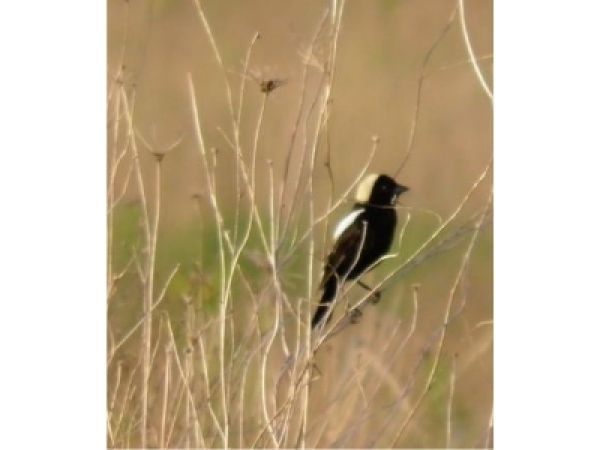
Splendor in the Grass
After traveling 6,000 miles from Argentina, you make a stop in Alden, Illinois.
You are a bobolink, one of the most traveled migratory songbirds in the world, and the only male songbird in North America adorned with the colors white and off-white on your back opposite a black belly. Some describe you as wearing a tuxedo backwards. You weigh 1-2 ounces. You will make this journey of approximately 6,000 miles twice a year.
It is a morning in early May, the kind of dew-drenched, mint-scented morning that must have inspired the ancients to put up their maypoles and dance with utter joy—honoring the return of sun and new life.
I am walking across an 8-acre hayfield that my wife, Nan Seidler, and I have placed into a conservation easement with The Land Conservancy of McHenry County.
On this particular spring morning comes another blessing from above.
Four pairs of bobolinks are circling over my head in a low, helicopter-like flight. According to poet Cullen Bryant in his poem, “Robert of Lincoln,”
the male bobolink says his name:
“…merrily singing on a briar and weed…Bob-o-link, bob-o-link, spink, spank, spink.”
Male bobolinks are one of the few songbirds that seem to prefer singing on the wing—a joyous twittering and bubbling, an ecstatic chorus of chiming notes rollicking upward.
Because bobolinks prefer grassy hay fields, they are a species that is running out of habitat. Generally, farmers cut their hay 2-3 times (cuttings) per summer. For dairy farmers, who plant alfalfa, the hay is most nutritious for dairy cattle when first cut early in June or late May. This is at the height of bobolink nesting, often destroying the nests, eggs and young birds.
However, holding off the cutting of our field, planted with the grasses timothy, orchard grass, and brome, until late July suits my neighbor, Dan Peironi and his wife, Roxie. They feed horses and goats who thrive on the grass hay. Dan recently told me that he had spotted bobolinks in a hayfield near his home just east of our site as we wondered one day if the bobolinks were back for the season.
Finally, a closing thought on nature’s hidden joys: bobolink males are polygynous meaning they mate with more than one female; and the females, polyandrous, meaning that their nests may contain eggs fertilized by many different males.
So, while the male bobolinks, on the wing, provide a twittering and acrobatic spectacle:
“what happens in the grass, stays in the grass.”
Farming with Nature: Bringing Back the Bobolink
Grassland birds, as a group, have suffered the most severe population decline of any other North American birds due to the enormous loss and fragmentation of their required habitat.
In McHenry County, hay production has declined in favor of row crops. And hay is cut earlier and more frequently, way before the time young birds have fledged their nests (mid-July and later).
There are however, a number of ways that farmers can help bring grassland birds back, by using “bird friendly” agricultural practices. These include: adjusting mowing practices by rotating the areas mowed, mowing the field from the inside out, using a flushing bar to scare wildlife out of the way while mowing, and delaying mowing until later in the season.
Alden Township landowner Jim May has been practicing delayed mowing for decades.